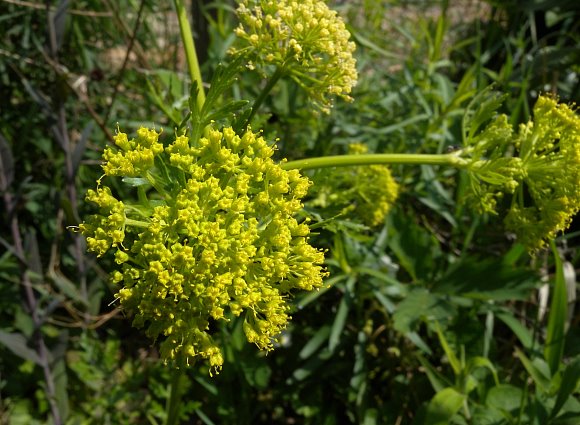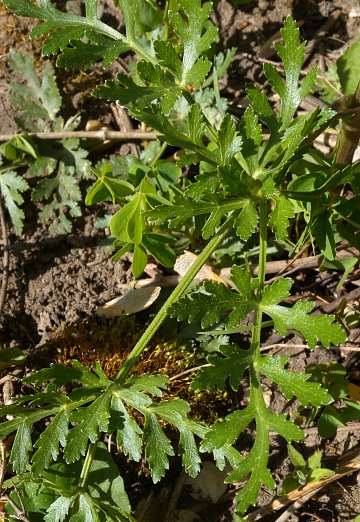
Eventually, this plant bolts to produce a single flowering stalk with a few alternate leaves. This stalk is light green to pale brownish red, terete (round in cross-section), somewhat stout, and 1½-3' tall. It is unbranched, except toward the apex, where the umbels of flowers occur, and usually it is covered with short fine pubescence to a greater or less extent. The alternate leaves are up to 3" long and 3" across, pinnate-pinnatifid in structure, triangular in outline, and sessile; they become smaller in size as they ascend the stem. Similar to the basal leaves, the leaflets of alternate leaves are moderately to deeply divided into pinnate lobes; these lobes usually have a few coarse teeth along their margins. The surface of alternate leaves is medium green and glabrous (or nearly so). The central stalk terminates in a few compound umbels of flowers that span 1½-3" across. In addition, lateral compound umbels of flowers often develop from the axils of upper leaves on peduncles 2" long or more. Depending on their stage of development, the tops of these umbels are
Cultivation: The preference is full sun, mesic to dry conditions, and soil containing loam, rocky material, or sand. The seeds can be difficult to germinate, requiring a winter dormancy of about 120 days, and each plant is rather slow to develop after germination has occurred.
Range & Habitat: The native Prairie Parsley occurs in scattered areas of northern, southern, and west-central Illinois, where it is fairly uncommon. Populations of this plant within the state appear to be declining. Illinois lies along the NE range limit of this plant. Habitats include upland prairies, hill prairies, limestone glades, chert glades, thinly wooded bluffs, and savannas. Prairie Parsley is an indicator plant of original prairie. It is rarely found in disturbed areas. This conservative species may require occasional wildfires to remove excess brush and debris, and to facilitate germination of the seeds.
Faunal Associations: The tiny flowers attract primarily small bees, miscellaneous flies, and occasional wasps (Robertson, 1929). Prairie Parsley is one of the species in the Carrot family that the oligolectic bee, Andrena ziziae, visits for pollen and nectar. The caterpillars of a butterfly, Papilio polyxenes asterius (Black Swallowtail), feed on the foliage of this plant. Cattle and other mammalian herbivores browse readily on the non-toxic foliage.

Photographic Location: The wildflower garden of the webmaster in Urbana, Illinois.
Comments: Most people might regard Prairie Parsley as another weed, but it is a conservative native plant with high fidelity to prairies. This plant is perhaps at its most attractive when its fruits have reached the showy yellow stage. The native Prairie Parsley in Illinois should not be confused with either Wild Parsnip (Pastinaca sativa) or Golden Alexanders (Zizia aurea). Like Prairie Parsley, Wild Parsnip and Golden Alexanders have compound umbels of small yellow flowers, but they differ by having simple-pinnate leaves with leaflets that are less lobed. Another species, Flat-Leaved Parsley (Petroselinum crispum neapolitanum), has compound leaves and compound umbels of flowers that are very similar to those of Prairie Parsley, but Flat-Leaved Parsley differs by having mature seeds that lack winged margins.